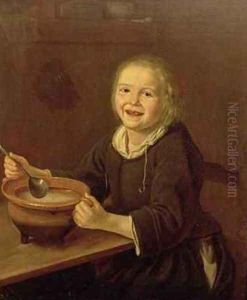Reynier Fransz Hals Paintings
Reynier Fransz Hals was a Dutch Golden Age painter, born in 1627 in Haarlem, Netherlands. He was the son of Frans Hals, one of the most celebrated painters of the era, known for his lively and loose brushwork. It is not surprising that Reynier would follow in his father's footsteps, becoming an artist in his own right, although he did not achieve the same level of fame as his father.
Reynier likely received his early training in the workshop of his father and was influenced by his father's style and the general artistic environment of Haarlem at the time, which was a hub for Dutch painters. Despite this, there is little information about his career and the extent of his oeuvre, which suggests that he did not reach the same level of notoriety as Frans Hals.
Reynier's works are rarely documented, and few have been attributed to him with certainty. His style, as seen in the few paintings attributed to him, was similar to that of his father's, characterized by a certain vivacity and a focus on portraiture. However, Reynier's work is often considered to lack the vitality and precision of his father's best pieces.
Reynier lived during a time when the art market in the Netherlands was thriving, but also highly competitive. This competition may have impacted his ability to stand out among his contemporaries. In addition, the overshadowing fame of his father could have made it difficult for Reynier to establish a distinct reputation.
Reynier Fransz Hals died relatively young in 1672. The scarcity of information about his life and work means that his contribution to the art world is not as well remembered as that of many of his contemporaries. Nonetheless, his association with the Hals family and the Dutch Golden Age of painting grants him a place in the historical narrative of art during that prolific period.
